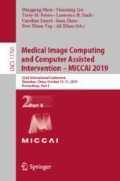Abstract
Developmental dysplasia of the hip (DDH) is one of the most common congenital disorders seen in newborns. Undetected cases may lead to serious consequences including limping, leg length discrepancy, pain, osteoarthritis, disability, and total hip replacement. Diagnosis typically relies on ultrasound (US) screening of the infant hip between 0–4 months of age. An inexpensive and safe non-ionizing modality, US imaging enables measurement of DDH metrics based on hip bone features such as the \(\alpha \) angle. Though DDH assessment remains mostly a manual process in clinical practice, notorious for its significant operator variability, a number of automated measurement methods were recently proposed. These computational methods rely on highly engineered, hand-crafted features most notable of which are phase-based bone image features. Though promising, especially as they were shown to significantly reduce user variability, challenges remain with regards to robustness, as well as generalizability to new data. To improve bone localization, from which the metrics are calculated, we first build upon recent phase-based feature extraction by applying spatial anatomical priors to eliminate false positives and accurately segment the ilium and acetabulum contour. Second, we propose the use of deep-learned features, using the popular U-Net with single and multi-channel inputs. We observe superior performance of deep-learned features compared to the enhanced engineered features including shadow peak and confidence-weighted phase symmetry. We present quantitative evaluation on extensive data from two clinical datasets collected with two different ultrasound probes as part of a study we performed on a cohort of 103 pediatric patients.
Access this chapter
Tax calculation will be finalised at checkout
Purchases are for personal use only
References
Alsinan, A.Z., Patel, V.M., Hacihaliloglu, I.: Automatic segmentation of bone surfaces from ultrasound using a filter-layer-guided CNN. Int. J. Comput. Assist. Radiol. Surg. 14, 775–783 (2019)
Hareendranathan, A.R., et al.: Toward automatic diagnosis of hip dysplasia from 2D ultrasound. In: Proceedings of International Symposium on Biomedical Imaging, pp. 982–985 (2017)
Jackson, J., Runge, M., Nye, N.: Common questions about developmental dysplasia of the hip. Am. Fam. Physician 90(12), 843–850 (2014)
Loder, R.T., Skopelja, E.N.: The epidemiology and demographics of hip dysplasia. ISRN Orthop. 2011, 1–46 (2011)
Mostofi, E., et al.: Reliability of 2D and 3D ultrasound for infant hip dysplasia in the hands of novice users. Eur. Radiol. 29(3), 1489–1495 (2019)
Pandey, P., Quader, N., Mulpuri, K., Guy, P., Garbi, R., Hodgson, A.J.: Shadow peak: accurate real-time bone segmentation for ultrasound and developmental dysplasia of the hip. In: 19th Annual Meeting of the International Society for Computer Assisted Orthopaedic Surgery, New York (2019)
Paserin, O., Mulpuri, K., Cooper, A., Hodgson, A.J., Garbi, R.: Real time RNN based 3D ultrasound scan adequacy for developmental dysplasia of the hip. In: Frangi, A.F., Schnabel, J.A., Davatzikos, C., Alberola-López, C., Fichtinger, G. (eds.) MICCAI 2018. LNCS, vol. 11070, pp. 365–373. Springer, Cham (2018). https://doi.org/10.1007/978-3-030-00928-1_42
Quader, N., Hodgson, A., Mulpuri, K., Cooper, A., Abugharbieh, R.: Towards reliable automatic characterization of neonatal hip dysplasia from 3D ultrasound images. In: Ourselin, S., Joskowicz, L., Sabuncu, M.R., Unal, G., Wells, W. (eds.) MICCAI 2016. LNCS, vol. 9900, pp. 602–609. Springer, Cham (2016). https://doi.org/10.1007/978-3-319-46720-7_70
Quader, N., Hodgson, A., Mulpuri, K., Savage, T., Abugharbieh, R.: Automatic assessment of developmental dysplasia of the hip. In: Proceedings of International Symposium on Biomedical Imaging, 13–16 July 2015 (2015)
Ronneberger, O., Fischer, P., Brox, T.: U-Net: convolutional networks for biomedical image segmentation. In: Navab, N., Hornegger, J., Wells, W.M., Frangi, A.F. (eds.) MICCAI 2015. LNCS, vol. 9351, pp. 234–241. Springer, Cham (2015). https://doi.org/10.1007/978-3-319-24574-4_28
Villa, M., Dardenne, G., Nasan, M., Letissier, H., Hamitouche, C., Stindel, E.: FCN-based approach for the automatic segmentation of bone surfaces in ultrasound images. Int. J. Comput. Assist. Radiol. Surg. 13(11), 1707–1716 (2018)
Zhang, Z., Tang, M., Cobzas, D., Zonoobi, D., Jagersand, M., Jaremko, J.L.: End-to-end detection-segmentation network with ROI convolution. In: Proceedings of International Symposium on Biomedical Imaging (ISBI), April 2018, pp. 1509–1512 (2018)
Acknowledgement
This work was funded by the Natural Sciences and Engineering Research Council (grant no. CHRP 478466-15), the Canadian Institutes of Health Research (grant no. CPG-140180), and the Institute for Computing, Information, and Cognitive Systems (ICICS) at UBC. We would also like to thank NVIDIA Corporation for supporting our research through their GPU Grant Program by donating the GeForce Titan Xp.
Author information
Authors and Affiliations
Corresponding author
Editor information
Editors and Affiliations
Rights and permissions
Copyright information
© 2019 Springer Nature Switzerland AG
About this paper
Cite this paper
El-Hariri, H., Mulpuri, K., Hodgson, A., Garbi, R. (2019). Comparative Evaluation of Hand-Engineered and Deep-Learned Features for Neonatal Hip Bone Segmentation in Ultrasound. In: Shen, D., et al. Medical Image Computing and Computer Assisted Intervention – MICCAI 2019. MICCAI 2019. Lecture Notes in Computer Science(), vol 11765. Springer, Cham. https://doi.org/10.1007/978-3-030-32245-8_2
Download citation
DOI: https://doi.org/10.1007/978-3-030-32245-8_2
Published:
Publisher Name: Springer, Cham
Print ISBN: 978-3-030-32244-1
Online ISBN: 978-3-030-32245-8
eBook Packages: Computer ScienceComputer Science (R0)


